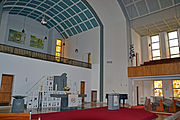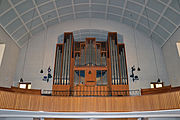Apostle Church (Essen)
The Apostle Church is a Protestant church in the Essen district of Frohnhausen . It is a church of the Evangelical Parish Essen-Frohnhausen, which belongs to the Essen church district and thus to the regional church of the Evangelical Church in the Rhineland . To the east of the Apostle Church there is an emergency church designed by the architect Otto Bartning .
history
The Essen district of Frohnhausen, located to the west near the city center, had already grown into the most densely populated area of the city by the beginning of the 20th century. The reason were newly established settlements for the steadily growing number of workers who were employed in the nearby collieries and in the Krupp cast steel factory in what is now the Westviertel . Krupp subsidized the construction of the church with 75,000 marks and thus made the construction of the Apostle Church possible. In 1904 the city of Essen acquired Grund from the farmer Pollerberg called Lange. The Pollerbergshof , an urban reform project, was built here. Part of it, on which the Apostle Church was to be built, was sold to the church in 1906.
The church building
The foundation stone for the Apostle Church was laid on June 23, 1912 . After the Luther Church and the Christ Church, it was the third Protestant church in the area of the Altendorf Mayor, which was separated from Borbeck in 1877 and incorporated into Essen in 1901 . The church building was built according to plans by the architect Ewald Wachenfeld from Hagen , whose design won the architecture competition announced by architects Robert Schmidt and Friedrich Pützer in 1911. A field path cross decorated with the image of Christ had to give way to the new building project, which was located on the church path of the southern Frohnhauser residents. For several centuries the cross, surrounded by gardens and fields, was a station for processions.
In contrast to the first two churches in the west of Essen, the Apostle Church was a community center consisting of a church, parish and community center with a forecourt. In the former parish hall there was space for 400 people in a parish hall, and a sexton's apartment was in its attic. The high hipped roof of the church building stood out from the surrounding buildings. The interior followed the Wiesbaden program , so that the altar, pulpit, singing stage and organ were in one line, and the pews were angled. The church was characterized by a reform architecture shaped by neoclassicism . A large lettering of the title of the song text by Martin Luther , A strong castle is our God , once covered the arch above the altar, under which the organ was then.
When laying the tower foundation, you came across an old coal shaft, so that you had to go much deeper into the ground. A chapel for baptisms or weddings was built on the ground floor of the 48-meter-high tower, which was modeled in many details on the Campanile of Venice , which could be connected to the church hall with the help of a sliding wall. With a grant from the city of 1,500 marks, the tower received an important clock from the tower clock factory JF Weule . This had already been shown and awarded at the world exhibitions in Brussels in 1910 and Turin in 1911 (Esposizione internazionale dell'industria e del lavoro). Externally, the tower received the largest clock faces in Essen in 1913 with a diameter of 3.85 meters.
The three motor-driven bells were cast in steel at the Bochumer Verein in 1912 and lifted into the bell cage of the tower through openings in the floor on February 7, 1913 . They were rung for the first time on February 10, 1913. The floor opening was closed in such a way that it could no longer be opened during the Second World War and so the bells were spared the so-called metal donation of the German people . The two smaller, outer bells weigh 1200 kg and 1560 kg, the middle and largest weighs 2600 kg. You are tuned to c , des and es . The two smaller bells are marked with the Bible verses "Jesus Christ, yesterday and today and the same forever", Hebrews 12: 3 and "Oh land, land, country, hear the word of the Lord", Jeremiah 22:29 .
On November 2, 1913, the new church with a thousand seats and already installed electricity was inaugurated by Pastor Cürlis. Inside it was a caseless organ by the Barmen organ builder Paul Faust . The Altendorf community , to which the Apostle Church belonged, had seven pastors with around 24,000 members at that time.
At the time of the world wars
In memory of the fallen in World War I , plaques with name inscriptions were unveiled on February 28, 1925, which were then destroyed in the Second World War. Stick bombs damaged the roof of the Apostle Church in April 1943 . Air raids destroyed the community center on March 26, 1944. On March 11, 1945, the steel roof structure collapsed and destroyed the first emergency church under construction. Only the steeple of the Apostle Church survived the war. On June 24, 1945, the dormitory of the Wilhelm Augusta Children's Home on Aachener Strasse was used as the Apostle Hall until the emergency church was inaugurated.
The emergency church
The emergency church designed by Otto Bartning was mostly built by community members as a voluntary work. The hall building stands on the foundations of the former parish hall and was inaugurated on October 30, 1949. On this occasion, the community moved from the former municipal Wilhelm Augusta children's home, which was used as a church, to the emergency church. The three bells of the church tower, which had stood still during the war, rang. The construction was made possible by donations from the Evangelical and Reformed Church in Chicago, i.e. from Evangelical Christians from the USA . Neither architect Bartning (because of illness) nor the President of the Reformed Church, L. W. Goebel, were present at the inauguration ceremony. Instead, the President Heinrich Held , the Mayor Josef Aust and, as a representative of the World Council of Churches, his representative for Germany, Propst Halfdan Høgsbro from Bad Homburg .
The emergency church is located directly on Mülheimer Strasse between the Apostle Church and the Apostle House, which was built in the 1960s. Today it is used for celebrations and cultural exhibitions. In the interior, the rubble stones are still visible, which were rebuilt for the choir walls, among other things. The wooden nail ties that support the wooden roof structure and were manufactured in Karlsruhe are also recognizable. With the help of these binders, a kind of series production of this type of emergency churches was possible, of which 43 were built in Germany by 1951 according to Bartnings plans. 41 of them still exist today. It took five months to build the Apostle Emergency Church with around 450 seats. In 2009, the old style window band was renewed with double glazing in order to get a grip on leaks. After further renovations, it was reopened together with the newly attached forum on October 31, 2009.
reconstruction
The Apostle Church was rebuilt little changed by the Essen architect Reinhold Jerichow from 1956 and completed on November 2, 1958. The lead-framed antique glass windows in the former chapel from 1958 are by Ursula Graeff-Hirsch and show the four symbols of the evangelists.
On September 18, 1966 the new Schuke organ, financed by donations, with 46 stops and three manuals was inaugurated. It is now on the tower gallery and no longer above the altar, like the old organ. On March 25, 1968, the presbytery decided, after collecting signatures against noise, to abolish the hour strike and the death knell and to shorten the church bell to five minutes.
The original clockwork, the tower clock replaced by a radio clock in 2000, can still be viewed in the tower today. However, earlier information does not match this movement, so that it is assumed that the original was lost in the chaos of war and was replaced.
Since January 12, 2011, the Apostle Church has been one of the reliably open churches .
On September 23, 2011, the seven-ton, 2.60-meter-high marble sculpture Focus of Life was unveiled on the forecourt of the church . It comes from the Essen-born artist Simone Elsing , who lives and works in Berlin.
- Furnishing:
Forum Apostle Center
On October 31, 2009, almost the 60th anniversary of the Apostle Emergency Church, the glass forum was inaugurated. The construction project cost around half a million euros, which was raised without public funds. Among other things, the municipality sold a plot of land on Aachener Strasse to a service company in the city. The forum now represents a structural connection between Mülheimer Strasse and An der Apostelkirche . It offers around 137 square meters of space for a small café, as well as for exhibitions, bazaars, meetings or small concerts.
Goose Rider Fountain
The goose rider fountain on the church square has been a listed building since 1994 . It was also created in 1913 and was also designed by the Hagen architect Ewald Wachenfeld.
Planned closure and abandonment (2019)
At the end of September 2019, the presbytery informed the parish that the closure and abandonment of the Apostle Church was "inevitable" due to the decline in membership and investment backlog. The essential smaller emergency church is to serve as the central preaching place of the community in the future.
Clarification of the resolutions is requested in a protest letter to the superintendent signed by over 100 Frohnhausen residents. A protest rally in front of the church was planned for November 14th.
Web links
- Evangelical Church Community Essen-Frohnhausen - Apostle Center
- Description of this sight on the route of industrial culture
swell
The article's underlying sources are the writings:
- Robert Welzel: Documentation 90 years of the Apostle Center, 90 years of community history in Frohnhausen
- Robert Welzel: Frohnhausen's rubble church turns 50, documentation on the emergence of the Apostle Emergency Church
- Robert Welzel: The goose rider fountain at the Apostle Church - architecture of the imperial era in Frohnhausen; January 2008
References and footnotes
- ^ Research Center for Glass Painting of the 20th Century eV ; accessed on October 11, 2018
- ↑ Ev. Church parish archive , offline, last accessed on March 21, 2016
- ↑ Stadtspiegel Essen, West-Anzeiger, issue No. 83 of October 17, 2009
- ↑ Excerpt from the list of monuments of the city of Essen (PDF; 413 kB); accessed on October 11, 2018
- ^ Church crisis - two other parishes in Essen are facing closings , WAZ . September 26, 2019. Retrieved November 14, 2019.
Coordinates: 51 ° 26 ′ 45.2 " N , 6 ° 58 ′ 27.7" E









